|
 Agrocybe praecox Agrocybe praecox
SynonymsPholiota praecox
Agaricus praecox
BiostatusPresent in region - Exotic
Images (click to enlarge)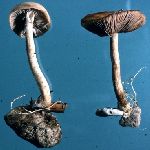
Owner: B.P. Segedin | 
Owner: B.P. Segedin | 
Owner: J.A. Cooper | 
Caption: Collections BD92 on woodchip mulch
Owner: B. Dee | 
Owner: B. Dee | 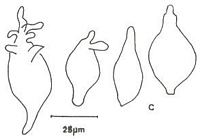 | 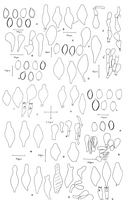
Caption: A-D Segedin 751, A. Basidiospores; B. Pleurocystidia; C & C' Caulocystidia; D. Pileipellis. B-D Taylor 1254A, E. Basidiospores; F. Cheilocystidia; G. Pleurocystidia. H-K Taylor 1261, H. Basidiospores; I. Pleurocystidia; J. Basidia; K. Cheilocystidia. L-O | 
Caption: A & I-J Taylor 318, A. Habit sketch and section (A'); 1. Pleurocystidia; J. Cheilocystidia. B-D Taylor 317, B. Habit sketch and section (B'); C. Pleurocystidia; D. Cheilocystidia. E. Pleurocystidia Orton 2102. F-G Orton 2101, F. Cheilocystidia; G | 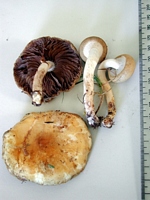
Owner: J.A. Cooper | 
Owner: J.A. Cooper | 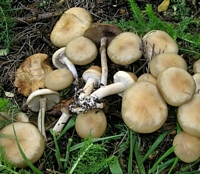
Owner: J.A. Cooper | 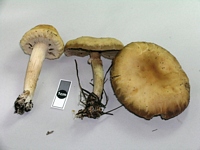
Owner: J.A. Cooper | 
Caption: upper cheilocystidia and basidium, scale=20um. Lower spores, scale=10um.
Owner: J.A. Cooper |
Article: Watling, R.; Taylor, G.M. (1987). Observations on the Bolbitiaceae: 27. Preliminary account of the Bolbitiaceae of New Zealand. Bibliotheca Mycologica 117: 61 p. + 17 pl.
Description: Description of New Zealand collections;-
Pileus (20-) 33-80 mm, convex with inrolled margin, purplish brown when very young soon yellow ochre to yellowish, browning with age, smooth, texture of kid-glove; margin smooth with narrow greyish border where flesh is thin, when immature persistent purplish brown, often with velar remnants. Stipe 60-80 x 6-8 mm, equal or tapered upwards from swollen or bulbous base, annulate, whitish and striate at apex, yellowish below ring but browning on handling, solid then hollow, attached to conspicuous white mycelial cords at base; ring membranous, superior, whitish, darkening with age. Gills adnate-sinuate, crowded, pale cream-colour at first becoming pinkish brown-grey finally darkening. Flesh relatively thick, pale cream-colour with a grey line above gills, creamy white, fibrous in stipe. Smell sour.
Basidiospores deep brown in mass, 8-9.5(-10) x (4.5-)5-6 µm, ellipsoid, smooth, thick-walled, relatively strongly coloured in water and aqueous alkali solutions; germ-pore central, distinct. Basidia 4-spored, 20-25 x 6-7.5 µm. Cheilocystidia a mixture of clavate to vesiculose cells (30-45 x 18-20 µm) with a few ventricose cells 15-20 x 5-10 µm; pleurocystidia frequent, prominent, mucronate, lageniform or even ampulliform, 45-55 x 18-25 µm, sometimes with minute granulations at apex. Hymenophoral trama parallel with a few oleiferous hyphae. Pileipellis a palisadoderm of spheropedunculate cells 17-38 µm diam. Clamp-connections present.
Notes: Colenso b 283 cannot be added to this list meantime although Horak (1971b) states 'all found characters correspond well with those of the type' i.e., A. praecox.
A widespread agaric of gardens and fields in western Europe from late spring until summer even into late August in more northerly regions; probably introduced into New Zealand. Material has been compared with that from Europe (Scotland; Orton 2101-3 inci & Wat. 11745 in E). This is a world wide species of cultivated and disturbed areas: it is a rather variable species, or more likely a complex of taxa; see Walling, 1985. Cultural studies would be valuable. This species has been recorded by Colenso (1886) and figured by Massee (1898) The description is taken from Taylor's collections although the material in PDD accompanied by short descriptions agree in all major details.
A collection in PDD (on sawdust, Mt. Albert, Auckland City, ix 1969, legit K. R. W. Hammett, PDD 29208) thought to be A. praecox has processes on the pleurocystidia similar to, although less distinct, than those in A. arvalis. This type of pleurocystidia is also found in A. acericola (Peck) Singers. Overholts and the Hammett collection may represent this widespread N. American taxon. See above.
A collection from Otago (amongst Ammophila in dunes, near Brighton, 28 xii 1969, Austwick 1921) may also represent a slender A. praecox but in the absence of field-data, other than an uninformative pencil sketch, this cannot be confirmed; in such areas in Britain A. sphaleromorpha (Bull.: Fr.) Fayod might be expected. Vesiculose cheilocystidia could not be located although typical ampulliform pleurocystidia clearly approached the gill-edge; some basidiospores in any one mount were also rather large, e.g. 11-12 x 7-8 µm. Equally, filamentous cheilocystidia taken as characteristic of A. cf. puiggarii were not found; see below.
|